Biology
From Wikipedia, the free encyclopedia
For other uses, see Biology (disambiguation).

Biology deals with the study of the many varieties of living organisms. Clockwise from top left: Salmonella typhimurium, Phascolarctos cinereus, Athyrium filix-femina, Amanita muscaria, Agalychnis callidryas, and Brachypelma smithi
 |
| Part of a series on Science |
- Cells are the basic unit of life
- New species and inherited traits are the product of evolution
- Genes are the basic unit of heredity
- An organism regulates its internal environment to maintain a stable and constant condition
- Living organisms consume and transform energy.
Main article: History of biology
Although biology in its modern form is a relatively recent development, sciences related to and included within it have been studied since ancient times. Natural philosophy was studied as early as the ancient civilizations of Mesopotamia, Egypt, the Indian subcontinent, and China. However, the origins of modern biology and its approach to the study of nature are most often traced back to ancient Greece.[4] While the formal study of medicine dates back to Hippocrates (ca. 460 BC – ca. 370 BC), it was Aristotle (384 BC – 322 BC) who contributed most extensively to the development of biology. Especially important are his History of Animals and other works where he showed naturalist leanings, and later more empirical works that focused on biological causation and the diversity of life. Aristotle's successor at the Lyceum, Theophrastus, wrote a series of books on botany that survived as the most important contribution of antiquity to the plant sciences, even into the Middle Ages.
Scholars of the medieval Islamic world who wrote on biology included al-Jahiz (781–869), Al-Dinawari (828–896), who wrote on botany,[5] and Rhazes (865–925) who wrote on anatomy and physiology. Medicine was especially well studied by Islamic scholars working in Greek philosopher traditions, while natural history drew heavily on Aristotelian thought, especially in upholding a fixed hierarchy of life.
Biology began to quickly develop and grow with Antony van Leeuwenhoek's dramatic improvement of the microscope. It was then that scholars discovered spermatozoa, bacteria, infusoria and the sheer strangeness and diversity of microscopic life. Investigations by Jan Swammerdam led to new interest in entomology and built the basic techniques of microscopic dissection and staining.[6]
Advances in microscopy also had a profound impact on biological thinking itself. In the early 19th century, a number of biologists pointed to the central importance of the cell. In 1838 and 1839, Schleiden and Schwann began promoting the ideas that (1) the basic unit of organisms is the cell and (2) that individual cells have all the characteristics of life, although they opposed the idea that (3) all cells come from the division of other cells. Thanks to the work of Robert Remak and Rudolf Virchow, however, by the 1860s most biologists accepted all three tenets of what came to be known as cell theory.[7]
Meanwhile, taxonomy and classification became a focus in the study of natural history. Carolus Linnaeus published a basic taxonomy for the natural world in 1735 (variations of which have been in use ever since), and in the 1750s introduced scientific names for all his species.[8] Georges-Louis Leclerc, Comte de Buffon, treated species as artificial categories and living forms as malleable—even suggesting the possibility of common descent. Though he was opposed to evolution, Buffon is a key figure in the history of evolutionary thought; his work influenced the evolutionary theories of both Lamarck and Darwin.[9]
Serious evolutionary thinking originated with the works of Jean-Baptiste Lamarck. However, it was the British naturalist Charles Darwin, combining the biogeographical approach of Humboldt, the uniformitarian geology of Lyell, Thomas Malthus's writings on population growth, and his own morphological expertise, that created a more successful evolutionary theory based on natural selection; similar reasoning and evidence led Alfred Russel Wallace to independently reach the same conclusions.[10]
The discovery of the physical representation of heredity came along with evolutionary principles and population genetics. In the 1940s and early 1950s, experiments pointed to DNA as the component of chromosomes that held genes. A focus on new model organisms such as viruses and bacteria, along with the discovery of the double helical structure of DNA in 1953, marked the transition to the era of molecular genetics. From the 1950s to present times, biology has been vastly extended in the molecular domain. The genetic code was cracked by Har Gobind Khorana, Robert W. Holley and Marshall Warren Nirenberg after DNA was understood to contain codons. Finally, the Human Genome Project was launched in 1990 with the goal of mapping the general human genome. This project was essentially completed in 2003,[11] with further analysis still being published. The Human Genome Project was the first step in a globalized effort to incorporate accumulated knowledge of biology into a functional, molecular definition of the human body and the bodies of other organisms.
Foundations of modern biology
Much of modern biology can be encompassed within five unifying principles: cell theory, evolution, genetics, homeostasis, and energy.[2]Cell theory
Main article: Cell theory
Cell theory states that the cell is the fundamental unit of life, and that all living things are composed of one or more cells or the secreted products of those cells (e.g. shells). All cells arise from other cells through cell division. In multicellular organisms, every cell in the organism's body derives ultimately from a single cell in a fertilized egg. The cell is also considered to be the basic unit in many pathological processes.[12] Additionally, the phenomenon of energy flow occurs in cells in processes that are part of the function known as metabolism. Finally, cells contain hereditary information (DNA) which is passed from cell to cell during cell division.Evolution
Main article: Evolution
A central organizing concept in biology is that life changes and develops through evolution, and that all life-forms known have a common origin. Introduced into the scientific lexicon by Jean-Baptiste de Lamarck in 1809,[13] evolution was established by Charles Darwin fifty years later as a viable theory when he articulated its driving force: natural selection.[14][15] (Alfred Russel Wallace is recognized as the co-discoverer of this concept as he helped research and experiment with the concept of evolution.)[16] Evolution is now used to explain the great variations of life found on Earth.Darwin theorized that species and breeds developed through the processes of natural selection and artificial selection or selective breeding.[17] Genetic drift was embraced as an additional mechanism of evolutionary development in the modern synthesis of the theory.[18]
The evolutionary history of the species—which describes the characteristics of the various species from which it descended—together with its genealogical relationship to every other species is known as its phylogeny. Widely varied approaches to biology generate information about phylogeny. These include the comparisons of DNA sequences conducted within molecular biology or genomics, and comparisons of fossils or other records of ancient organisms in paleontology.[19] Biologists organize and analyze evolutionary relationships through various methods, including phylogenetics, phenetics, and cladistics. (For a summary of major events in the evolution of life as currently understood by biologists, see evolutionary timeline.)
The theory of evolution postulates that all organisms on the Earth, both living and extinct, have descended from a common ancestor or an ancestral gene pool. This last universal common ancestor of all organisms is believed to have appeared about 3.5 billion years ago.[20] Biologists generally regard the universality and ubiquity of the genetic code as definitive evidence in favor of the theory of universal common descent for all bacteria, archaea, and eukaryotes (see: origin of life).[21]
Genetics
Main article: Genetics
DNA usually occurs as linear chromosomes in eukaryotes, and circular chromosomes in prokaryotes. A chromosome is an organized structure consisting of DNA and histones. The set of chromosomes in a cell and any other hereditary information found in the mitochondria, chloroplasts, or other locations is collectively known as its genome. In eukaryotes, genomic DNA is located in the cell nucleus, along with small amounts in mitochondria and chloroplasts. In prokaryotes, the DNA is held within an irregularly shaped body in the cytoplasm called the nucleoid.[24] The genetic information in a genome is held within genes, and the complete assemblage of this information in an organism is called its genotype.[25]
Homeostasis
Main article: Homeostasis
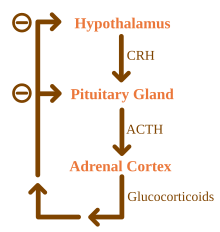
The hypothalamus secretes CRH, which directs the pituitary gland to secrete ACTH. In turn, ACTH directs the adrenal cortex to secrete glucocorticoids, such as cortisol.
The GCs then reduce the rate of secretion by the hypothalamus and the
pituitary gland once a sufficient amount of GCs has been released.[26]
To maintain dynamic equilibrium and effectively carry out certain functions, a system must detect and respond to perturbations. After the detection of a perturbation, a biological system normally respond through negative feedback. This means stabilizing conditions by either reducing or increasing the activity of an organ or system. One example is the release of glucagon when sugar levels are too low.
Energy
The organisms responsible for the introduction of energy into an ecosystem are known as producers or autotrophs. Nearly all of these organisms originally draw energy from the sun.[28] Plants and other phototrophs use solar energy via a process known as photosynthesis to convert raw materials into organic molecules, such as ATP, whose bonds can be broken to release energy.[29] A few ecosystems, however, depend entirely on energy extracted by chemotrophs from methane, sulfides, or other non-luminal energy sources.[30]
Some of the captured energy is used to produce biomass to sustain life and provide energy for growth and development. The majority of the rest of this energy is lost as heat and waste molecules. The most important processes for converting the energy trapped in chemical substances into energy useful to sustain life are metabolism[31] and cellular respiration.[32]
Research
Structural
Cell biology studies the structural and physiological properties of cells, including their behaviors, interactions, and environment. This is done on both the microscopic and molecular levels, for single-celled organisms such as bacteria as well as the specialized cells in multicellular organisms such as humans. Understanding the structure and function of cells is fundamental to all of the biological sciences. The similarities and differences between cell types are particularly relevant to molecular biology.
Anatomy considers the forms of macroscopic structures such as organs and organ systems.[34]
Genetics is the science of genes, heredity, and the variation of organisms.[35][36] Genes encode the information necessary for synthesizing proteins, which in turn play a large role in influencing (though, in many instances, not completely determining) the final phenotype of the organism. In modern research, genetics provides important tools in the investigation of the function of a particular gene, or the analysis of genetic interactions. Within organisms, genetic information generally is carried in chromosomes, where it is represented in the chemical structure of particular DNA molecules.
Developmental biology studies the process by which organisms grow and develop. Originating in embryology, modern developmental biology studies the genetic control of cell growth, differentiation, and "morphogenesis," which is the process that progressively gives rise to tissues, organs, and anatomy. Model organisms for developmental biology include the round worm Caenorhabditis elegans,[37] the fruit fly Drosophila melanogaster,[38] the zebrafish Danio rerio,[39] the mouse Mus musculus,,[40] and the weed Arabidopsis thaliana.[41][42] (A model organism is a species that is extensively studied to understand particular biological phenomena, with the expectation that discoveries made in that organism provide insight into the workings of other organisms.)[43]
Physiological
Main article: Physiology
Physiology studies the mechanical, physical, and biochemical
processes of living organisms by attempting to understand how all of the
structures function as a whole. The theme of "structure to function" is
central to biology. Physiological studies have traditionally been
divided into plant physiology and animal physiology, but some principles of physiology are universal, no matter what particular organism is being studied. For example, what is learned about the physiology of yeast cells can also apply to human cells. The field of animal physiology extends the tools and methods of human physiology to non-human species. Plant physiology borrows techniques from both research fields.Physiology studies how for example nervous, immune, endocrine, respiratory, and circulatory systems, function and interact. The study of these systems is shared with medically oriented disciplines such as neurology and immunology.
Evolutionary
Evolutionary research is concerned with the origin and descent of species, as well as their change over time, and includes scientists from many taxonomically oriented disciplines. For example, it generally involves scientists who have special training in particular organisms such as mammalogy, ornithology, botany, or herpetology, but use those organisms as systems to answer general questions about evolution.Evolutionary biology is partly based on paleontology, which uses the fossil record to answer questions about the mode and tempo of evolution,[44] and partly on the developments in areas such as population genetics[45] and evolutionary theory. In the 1980s, developmental biology re-entered evolutionary biology from its initial exclusion from the modern synthesis through the study of evolutionary developmental biology.[46] Related fields often considered part of evolutionary biology are phylogenetics, systematics, and taxonomy.
Systematics

A phylogenetic tree of all living things, based on rRNA gene data, showing the separation of the three domains bacteria, archaea, and eukaryotes as described initially by Carl Woese.
Trees constructed with other genes are generally similar, although they
may place some early-branching groups very differently, presumably
owing to rapid rRNA evolution. The exact relationships of the three
domains are still being debated.
Main article: Systematics
Multiple speciation events create a tree structured system of relationships between species. The role of systematics is to study these relationships and thus the differences and similarities between species and groups of species.[47] However, systematics was an active field of research long before evolutionary thinking was common.[48] The classification, taxonomy, and nomenclature of biological organisms is administered by the International Code of Zoological Nomenclature, International Code of Botanical Nomenclature, and International Code of Nomenclature of Bacteria for animals, plants, and bacteria, respectively. The classification of viruses, viroids, prions, and all other sub-viral agents that demonstrate biological characteristics is conducted by the International Code of Virus classification and nomenclature.[49][50][51][52] However, several other viral classification systems do exist.Traditionally, living things have been divided into five kingdoms: Monera; Protista; Fungi; Plantae; Animalia.[53]
However, many scientists now consider this five-kingdom system outdated. Modern alternative classification systems generally begin with the three-domain system: Archaea (originally Archaebacteria); Bacteria (originally Eubacteria); Eukaryota (including protists, fungi, plants, and animals)[54] These domains reflect whether the cells have nuclei or not, as well as differences in the chemical composition of the cell exteriors.[54]
Further, each kingdom is broken down recursively until each species is separately classified. The order is: Domain; Kingdom; Phylum; Class; Order; Family; Genus; Species.
There is also a series of intracellular parasites that are "on the edge of life"[55] in terms of metabolic activity, meaning that many scientists do not actually classify these structures as alive, due to their lack of at least one or more of the fundamental functions that define life. They are classified as viruses, viroids, prions, or satellites.
The scientific name of an organism is generated from its genus and species. For example, humans are listed as Homo sapiens. Homo is the genus, and sapiens the species. When writing the scientific name of an organism, it is proper to capitalize the first letter in the genus and put all of the species in lowercase. Additionally, the entire term may be italicized or underlined.[56][57]
The dominant classification system is called the Linnaean taxonomy. It includes ranks and binomial nomenclature. How organisms are named is governed by international agreements such as the International Code of Botanical Nomenclature (ICBN), the International Code of Zoological Nomenclature (ICZN), and the International Code of Nomenclature of Bacteria (ICNB).
A merging draft, BioCode, was published in 1997 in an attempt to standardize nomenclature in these three areas, but has yet to be formally adopted.[58] The BioCode draft has received little attention since 1997; its originally planned implementation date of January 1, 2000, has passed unnoticed. However, a 2004 paper concerning the cyanobacteria does advocate a future adoption of a BioCode and interim steps consisting of reducing the differences between the codes.[59] The International Code of Virus Classification and Nomenclature (ICVCN) remains outside the BioCode.
Ecology

Mutual symbiosis between clownfish of the genus Amphiprion that dwell among the tentacles of tropical sea anemones.
The territorial fish protects the anemone from anemone-eating fish, and
in turn the stinging tentacles of the anemone protects the clown fish
from its predators
Ecological systems are studied at several different levels, from individuals and populations to ecosystems and the biosphere. The term population biology is often used interchangeably with population ecology, although population biology is more frequently used when studying diseases, viruses, and microbes, while population ecology is more commonly when studying plants and animals. As can be surmised, ecology is a science that draws on several disciplines.
Ethology studies animal behavior (particularly that of social animals such as primates and canids), and is sometimes considered a branch of zoology. Ethologists have been particularly concerned with the evolution of behavior and the understanding of behavior in terms of the theory of natural selection. In one sense, the first modern ethologist was Charles Darwin, whose book, The Expression of the Emotions in Man and Animals, influenced many ethologists to come.[62]
Biogeography studies the spatial distribution of organisms on the Earth,[63] focusing on topics like plate tectonics, climate change, dispersal and migration, and cladistics.
Branches of biology
These are the main branches of biology:[64][65]- Aerobiology — the study of airborne organic particles
- Agriculture — the study of producing crops from the land, with an emphasis on practical applications
- Anatomy — the study of form and function, in plants, animals, and other organisms, or specifically in humans
- Arachnology — the study of arachnids
- Astrobiology — the study of evolution, distribution, and future of life in the universe—also known as exobiology, exopaleontology, and bioastronomy
- Biochemistry — the study of the chemical reactions required for life to exist and function, usually a focus on the cellular level
- Bioengineering — the study of biology through the means of engineering with an emphasis on applied knowledge and especially related to biotechnology
- Biogeography — the study of the distribution of species spatially and temporally
- Bioinformatics — the use of information technology for the study, collection, and storage of genomic and other biological data
- Biomathematics or Mathematical Biology — the quantitative or mathematical study of biological processes, with an emphasis on modeling
- Biomechanics — often considered a branch of medicine, the study of the mechanics of living beings, with an emphasis on applied use through prosthetics or orthotics
- Biomedical research — the study of the human body in health and disease
- Biophysics — the study of biological processes through physics, by applying the theories and methods traditionally used in the physical sciences
- Biotechnology — a new and sometimes controversial branch of biology that studies the manipulation of living matter, including genetic modification and synthetic biology
- Building biology — the study of the indoor living environment
- Botany — the study of plants
- Cell biology — the study of the cell as a complete unit, and the molecular and chemical interactions that occur within a living cell
- Conservation Biology — the study of the preservation, protection, or restoration of the natural environment, natural ecosystems, vegetation, and wildlife
- Cryobiology — the study of the effects of lower than normally preferred temperatures on living beings.
- Developmental biology — the study of the processes through which an organism forms, from zygote to full structure
- Ecology — the study of the interactions of living organisms with one another and with the non-living elements of their environment
- Embryology — the study of the development of embryo (from fecundation to birth). See also topobiology.
- Entomology — the study of insects
- Environmental Biology — the study of the natural world, as a whole or in a particular area, especially as affected by human activity
- Epidemiology — a major component of public health research, studying factors affecting the health of populations
- Ethology — the study of animal behavior
- Evolutionary Biology — the study of the origin and descent of species over time
- Genetics — the study of genes and heredity
- Herpetology — the study of reptiles and amphibians
- Histology — the study of cells and tissues, a microscopic branch of anatomy
- Ichthyology — the study of fish
- Integrative biology — the study of whole organisms
- Limnology — the study of inland waters
- Mammalogy — the study of mammals
- Marine Biology — the study of ocean ecosystems, plants, animals, and other living beings
- Microbiology — the study of microscopic organisms (microorganisms) and their interactions with other living things
- Molecular Biology — the study of biology and biological functions at the molecular level, some cross over with biochemistry
- Mycology — the study of fungi
- Neurobiology — the study of the nervous system, including anatomy, physiology and pathology
- Oceanography — the study of the ocean, including ocean life, environment, geography, weather, and other aspects influencing the ocean
- Oncology — the study of cancer processes, including virus or mutation oncogenesis, angiogenesis and tissues remoldings
- Ornithology — the study of birds
- Population biology — the study of groups of conspecific organisms, including
- Population ecology — the study of how population dynamics and extinction
- Population genetics — the study of changes in gene frequencies in populations of organisms
- Paleontology — the study of fossils and sometimes geographic evidence of prehistoric life
- Pathobiology or pathology — the study of diseases, and the causes, processes, nature, and development of disease
- Parasitology — the study of parasites and parasitism
- Pharmacology — the study and practical application of preparation, use, and effects of drugs and synthetic medicines
- Physiology — the study of the functioning of living organisms and the organs and parts of living organisms
- Phytopathology — the study of plant diseases (also called Plant Pathology)
- Psychobiology — the study of the biological bases of psychology
- Sociobiology — the study of the biological bases of sociology
- Structural biology — a branch of molecular biology, biochemistry, and biophysics concerned with the molecular structure of biological macromolecules
- Virology — the study of viruses and some other virus-like agents
- Zoology — the study of animals, including classification, physiology, development, and behavior (See also Entomology, Ethology, Herpetology, Ichthyology, Mammalogy, and Ornithology)
CELL DIVISION:
Mitochondria
Mitochondria
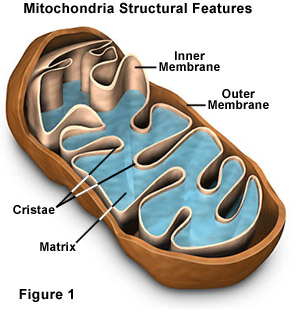
The elaborate structure of a mitochondrion is very important to the functioning of the organelle (see Figure 1). Two specialized membranes encircle each mitochondrion present in a cell, dividing the organelle into a narrow intermembrane space and a much larger internal matrix, each of which contains highly specialized proteins. The outer membrane of a mitochondrion contains many channels formed by the protein porin and acts like a sieve, filtering out molecules that are too big. Similarly, the inner membrane, which is highly convoluted so that a large number of infoldings called cristae are formed, also allows only certain molecules to pass through it and is much more selective than the outer membrane. To make certain that only those materials essential to the matrix are allowed into it, the inner membrane utilizes a group of transport proteins that will only transport the correct molecules. Together, the various compartments of a mitochondrion are able to work in harmony to generate ATP in a complex multi-step process.
Mitochondria are generally oblong organelles, which range in size between 1 and 10 micrometers in length, and occur in numbers that directly correlate with the cell's level of metabolic activity. The organelles are quite flexible, however, and time-lapse studies of living cells have demonstrated that mitochondria change shape rapidly and move about in the cell almost constantly. Movements of the organelles appear to be linked in some way to the microtubules present in the cell, and are probably transported along the network with motor proteins. Consequently, mitochondria may be organized into lengthy traveling chains, packed tightly into relatively stable groups, or appear in many other formations based upon the particular needs of the cell and the characteristics of its microtubular network.
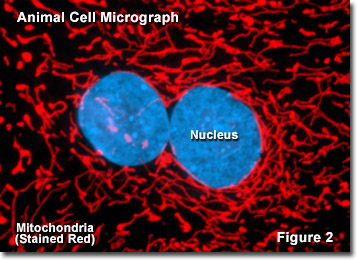
The mitochondrion is different from most other organelles because it has its own circular DNA (similar to the DNA of prokaryotes) and reproduces independently of the cell in which it is found; an apparent case of endosymbiosis. Scientists hypothesize that millions of years ago small, free-living prokaryotes were engulfed, but not consumed, by larger prokaryotes, perhaps because they were able to resist the digestive enzymes of the host organism. The two organisms developed a symbiotic relationship over time, the larger organism providing the smaller with ample nutrients and the smaller organism providing ATP molecules to the larger one. Eventually, according to this view, the larger organism developed into the eukaryotic cell and the smaller organism into the mitochondrion.
Mitochondrial DNA is localized to the matrix, which also contains a host of enzymes, as well as ribosomes for protein synthesis. Many of the critical metabolic steps of cellular respiration are catalyzed by enzymes that are able to diffuse through the mitochondrial matrix. The other proteins involved in respiration, including the enzyme that generates ATP, are embedded within the mitochondrial inner membrane. Infolding of the cristae dramatically increases the surface area available for hosting the enzymes responsible for cellular respiration.
Mitochondria are similar to plant chloroplasts in that both organelles are able to produce energy and metabolites that are required by the host cell. As discussed above, mitochondria are the sites of respiration, and generate chemical energy in the form of ATP by metabolizing sugars, fats, and other chemical fuels with the assistance of molecular oxygen. Chloroplasts, in contrast, are found only in plants and algae, and are the primary sites of photosynthesis. These organelles work in a different manner to convert energy from the sun into the biosynthesis of required organic nutrients using carbon dioxide and water. Like mitochondria, chloroplasts also contain their own DNA and are able to grow and reproduce independently within the cell.
In most animal species, mitochondria appear to be primarily inherited through the maternal lineage, though some recent evidence suggests that in rare instances mitochondria may also be inherited via a paternal route. Typically, a sperm carries mitochondria in its tail as an energy source for its long journey to the egg. When the sperm attaches to the egg during fertilization, the tail falls off. Consequently, the only mitochondria the new organism usually gets are from the egg its mother provided. Therefore, unlike nuclear DNA, mitochondrial DNA doesn't get shuffled every generation, so it is presumed to change at a slower rate, which is useful for the study of human evolution. Mitochondrial DNA is also used in forensic science as a tool for identifying corpses or body parts, and has been implicated in a number of genetic diseases, such as Alzheimer's disease and diabetes.
LEGENDS
Aristotle
From Wikipedia, the free encyclopediaFor other uses, see Aristotle (disambiguation).Ἀριστοτέλης, Aristotélēs 
Marble bust of Aristotle. Roman copy after a Greek bronze original by Lysippus c. 330 BC. The alabaster mantle is modernFull name Ἀριστοτέλης, Aristotélēs Born 384 BC
Stageira, ChalcidiceDied 322 BC (age 61 or 62)
EuboeaEra Ancient philosophy Region Western philosophy School Peripatetic school
AristotelianismMain interests Physics, Metaphysics, Poetry, Theatre, Music, Rhetoric, Politics, Government, Ethics, Biology, Zoology Notable ideas Golden mean, Reason, Logic, Syllogism, Passion
Aristotle (Greek: Ἀριστοτέλης, Aristotélēs) (384 BC – 322 BC)[1] was a Greek philosopher and polymath, a student of Plato and teacher of Alexander the Great. His writings cover many subjects, including physics, metaphysics, poetry, theater, music, logic, rhetoric, linguistics, politics, government, ethics, biology, and zoology. Together with Plato and Socrates (Plato's teacher), Aristotle is one of the most important founding figures in Western philosophy. Aristotle's writings were the first to create a comprehensive system of Western philosophy, encompassing morality and aesthetics, logic and science, politics and metaphysics.Part of a series on Aristotelianism 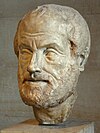
 Philosophy portal
Philosophy portal
Aristotle's views on the physical sciences profoundly shaped medieval scholarship, and their influence extended well into the Renaissance, although they were ultimately replaced by Newtonian physics. In the zoological sciences, some of his observations were confirmed to be accurate only in the 19th century. His works contain the earliest known formal study of logic, which was incorporated in the late 19th century into modern formal logic. In metaphysics, Aristotelianism had a profound influence on philosophical and theological thinking in the Islamic and Jewish traditions in the Middle Ages, and it continues to influence Christian theology, especially the scholastic tradition of the Catholic Church. His ethics, though always influential, gained renewed interest with the modern advent of virtue ethics. All aspects of Aristotle's philosophy continue to be the object of active academic study today. Though Aristotle wrote many elegant treatises and dialogues (Cicero described his literary style as "a river of gold"),[2] it is thought that the majority of his writings are now lost and only about one-third of the original works have survived.[3]
Life
Aristotle was born in Stageira, Chalcidice, in 384 BC, about 55 km (34 mi) east of modern-day Thessaloniki.[4] His father Nicomachus was the personal physician to King Amyntas of Macedon. Aristotle was trained and educated as a member of the aristocracy. At about the age of eighteen, he went to Athens to continue his education at Plato's Academy. Aristotle remained at the academy for nearly twenty years before quitting Athens in 348/47 BC. The traditional story about his departure reports that he was disappointed with the direction the academy took after control passed to Plato's nephew Speusippus upon his death, although it is possible that he feared anti-Macedonian sentiments and left before Plato had died.[5] He then traveled with Xenocrates to the court of his friend Hermias of Atarneus in Asia Minor. While in Asia, Aristotle traveled with Theophrastus to the island of Lesbos, where together they researched the botany and zoology of the island. Aristotle married Hermias's adoptive daughter (or niece) Pythias. She bore him a daughter, whom they named Pythias. Soon after Hermias' death, Aristotle was invited by Philip II of Macedon to become the tutor to his son Alexander the Great in 343 BC.[6]
Aristotle was appointed as the head of the royal academy of Macedon. During that time he gave lessons not only to Alexander, but also to two other future kings: Ptolemy and Cassander. In his Politics, Aristotle states that only one thing could justify monarchy, and that was if the virtue of the king and his family were greater than the virtue of the rest of the citizens put together.[7] Tactfully, he included the young prince and his father in that category. Aristotle encouraged Alexander toward eastern conquest, and his attitude towards Persia was unabashedly ethnocentric. In one famous example, he counsels Alexander to be 'a leader to the Greeks and a despot to the barbarians, to look after the former as after friends and relatives, and to deal with the latter as with beasts or plants'.[8]
By 335 BC he had returned to Athens, establishing his own school there known as the Lyceum. Aristotle conducted courses at the school for the next twelve years. While in Athens, his wife Pythias died and Aristotle became involved with Herpyllis of Stageira, who bore him a son whom he named after his father, Nicomachus. According to the Suda, he also had an eromenos, Palaephatus of Abydus.[9]
It is during this period in Athens from 335 to 323 BC when Aristotle is believed to have composed many of his works.[6] Aristotle wrote many dialogues, only fragments of which survived. The works that have survived are in treatise form and were not, for the most part, intended for widespread publication, as they are generally thought to be lecture aids for his students. His most important treatises include Physics, Metaphysics, Nicomachean Ethics, Politics, De Anima (On the Soul) and Poetics.
Aristotle not only studied almost every subject possible at the time, but made significant contributions to most of them. In physical science, Aristotle studied anatomy, astronomy, embryology, geography, geology, meteorology, physics and zoology. In philosophy, he wrote on aesthetics, ethics, government, metaphysics, politics, economics, psychology, rhetoric and theology. He also studied education, foreign customs, literature and poetry. His combined works constitute a virtual encyclopedia of Greek knowledge. It has been suggested that Aristotle was probably the last person to know everything there was to be known in his own time.[10]
Near the end of Alexander's life, Alexander began to suspect plots against himself, and threatened Aristotle in letters. Aristotle had made no secret of his contempt for Alexander's pretense of divinity, and the king had executed Aristotle's grandnephew Callisthenes as a traitor. A widespread tradition in antiquity suspected Aristotle of playing a role in Alexander's death, but there is little evidence for this.[11]
Upon Alexander's death, anti-Macedonian sentiment in Athens once again flared. Eurymedon the hierophant denounced Aristotle for not holding the gods in honor. Aristotle fled the city to his mother's family estate in Chalcis, explaining, "I will not allow the Athenians to sin twice against philosophy,"[12][13] a reference to Athens's prior trial and execution of Socrates. He died in Euboea of natural causes within the year (in 322 BC). Aristotle named chief executor his student Antipater and left a will in which he asked to be buried next to his wife.[14]
Logic
Main article: Term logicFor more details on this topic, see Non-Aristotelian logic.With the Prior Analytics, Aristotle is credited with the earliest study of formal logic, and his conception of it was the dominant form of Western logic until 19th century advances in mathematical logic. Kant stated in the Critique of Pure Reason that Aristotle's theory of logic completely accounted for the core of deductive inference.
History
Aristotle "says that 'on the subject of reasoning' he 'had nothing else on an earlier date to speak of'".[15] However, Plato reports that syntax was devised before him, by Prodicus of Ceos, who was concerned by the correct use of words. Logic seems to have emerged from dialectics; the earlier philosophers made frequent use of concepts like reductio ad absurdum in their discussions, but never truly understood the logical implications. Even Plato had difficulties with logic; although he had a reasonable conception of a deductive system, he could never actually construct one and relied instead on his dialectic.[16] Plato believed that deduction would simply follow from premises, hence he focused on maintaining solid premises so that the conclusion would logically follow. Consequently, Plato realized that a method for obtaining conclusions would be most beneficial. He never succeeded in devising such a method, but his best attempt was published in his book Sophist, where he introduced his division method.[17]
Analytics and the Organon
Main article: OrganonWhat we today call Aristotelian logic, Aristotle himself would have labeled "analytics". The term "logic" he reserved to mean dialectics. Most of Aristotle's work is probably not in its original form, since it was most likely edited by students and later lecturers. The logical works of Aristotle were compiled into six books in about the early 1st century AD:
- Categories
- On Interpretation
- Prior Analytics
- Posterior Analytics
- Topics
- On Sophistical Refutations
Aristotle's scientific method

Plato (left) and Aristotle (right), a detail of The School of Athens, a fresco by Raphael.
Aristotle gestures to the earth, representing his belief in knowledge
through empirical observation and experience, while holding a copy of
his Nicomachean Ethics in his hand, whilst Plato gestures to the heavens, representing his belief in The Forms.
For more details on this topic, see Aristotle's theory of universals.
Like his teacher Plato, Aristotle's philosophy aims at the universal. Aristotle, however, found the universal in particular
things, which he called the essence of things, while Plato finds that
the universal exists apart from particular things, and is related to
them as their prototype or exemplar.
For Aristotle, therefore, philosophic method implies the ascent from
the study of particular phenomena to the knowledge of essences, while
for Plato philosophic method means the descent from a knowledge of
universal Forms
(or ideas) to a contemplation of particular imitations of these. For
Aristotle, "form" still refers to the unconditional basis of phenomena but is "instantiated" in a particular substance (see Universals and particulars, below). In a certain sense, Aristotle's method is both inductive and deductive, while Plato's is essentially deductive from a priori principles.[18]
<script
src="http://adserver.adtechus.com/addyn/3.0/5308.1/1371243/0/225/ADTECH;target=_blank;grp=192;key=history
society+philosophy;kvqsegs=D;kvsource=other;kvtopicid=590974;kvchannel=HISTORY;misc=1324930722560"></script>
Theophrastus was one of the few Peripatetics who fully embraced Aristotle’s philosophy in all areas of metaphysics, physics, physiology, zoology, botany, ethics, politics, and history of culture. His general tendency was to strengthen the systematic unity of those subjects and to reduce the transcendental or Platonic elements of Aristotelianism as a whole. Of his few surviving works, the most important are Peri phytōn historia (“Inquiry into Plants”) and Peri phytōn aitiōn (“Growth of Plants”), comprising nine and six books, respectively. Of dubious origin are the smaller treatises attributed to him on fire, winds, signs of weather, scents, sensations, and other subjects. His notable Charaktēres (many English translations) consists of 30 brief and vigorous character sketches delineating moral types derived from studies that Aristotle had made for ethical and rhetorical purposes; this work later formed the basis for the masterpiece of Jean de La Bruyère, Les Caractères . . . (1699). In his ethical teachings, famous because of the assaults of the Stoic philosophers, Theophrastus reiterated Aristotle’s notion of a plurality of virtues with their relative vices and acknowledged a certain importance to external goods, which the Stoics held were mere luxuries for human life.
Gregor Mendel, Austrian botanist
H413/0282 Rights Managed
Caption: Gregor Johann Mendel.
Oil painting of the Austrian botanist Gregor Johann Mendel (1822-1884),
founder of genetics. This is part of the collection of Mendel relics
(Mendelianum) held at the Abbey of Saint Thomas in Brno, Czech Republic.
Mendel, the sixth abbot (from 1868) of the Abbey, conducted his
breeding experiments with pea plants here, discovering the statistical
laws of heredity. From his results, he postulated the existence of a
unit of heredity that is now called the gene. A new exhibition, The
Genius of Genetics, opened here in May 2002.
Release details:
Model and property releases are not available
Keywords:
19th century,
2002,
abbey of saint thomas,
abbot,
artwork,
augustinian,
austrian,
botanist,
botany,
brno,
czech republic,
evolutionary biology,
exhibition,
gene,
genes,
genetic,
geneticist,
gregor johann,
hereditary,
heredity,
historical,
history,
illustration,
laws,
male,
man,
mendel,
mendelianum,
monastery,
monk,
museum,
oil,
painting,
portraits,
religion,
religious,
researcher,
scientist,
surname m,
the genius of genetics
Back

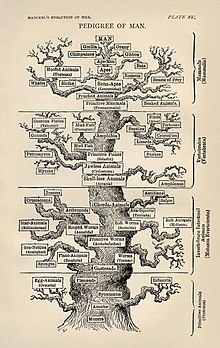


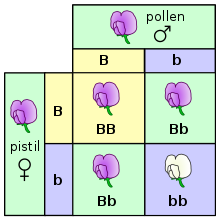



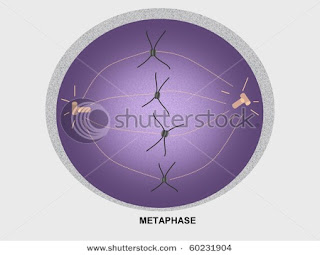



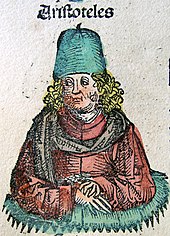
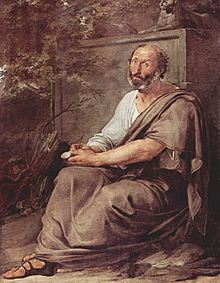

![Theophrastus, statue in the Botanic Garden, Palermo, Italy.
[Credit: Esculapio] Theophrastus, statue in the Botanic Garden, Palermo, Italy.
[Credit: Esculapio]](http://media-2.web.britannica.com/eb-media/78/124878-003-60EFBF77.gif)
